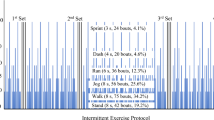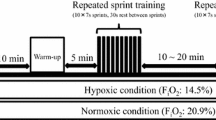Abstract
Purpose
For optimizing the quality of repeated-sprint training in hypoxia, the differences in the acute performance responses to a single session of repeated-sprint exercise with various (i) inspired oxygen fractions; (ii) exercise-to-recovery (E:R) ratios and (iii) recovery modalities were examined.
Methods
Ten male participants performed three sets, 5 × 5-s all-out treadmill sprints, E:R ratio of 1:5, passive recovery, in seven trials randomly. In four of the seven trials, hypoxic levels were set corresponding to sea level (SL1:5P), 1500 (1.5K1:5P), 2500 (2.5K1:5P), and 3500 m (3.5K1:5P), respectively. In a further two trials, the hypoxic level of 3.5K1:5P was maintained, while the E:R ratio was reduced to 1:4 (3.5K1:4P) and 1:3 (3.5K1:3P), respectively. In the last trial, the passive recovery mode of 3.5K1:5P was changed to active (3.5K1:5A).
Results
In comparison to SL1:5P, the averaged peak velocity (P-Vel), mean velocity (M-Vel), and velocity decrement score (Sdec) of the sprints, and the cumulative HR-based training impulse (cTRIMP) in 1.5K1:5P and 2.5K1:5P were well maintained. Minor decrement in the M-Vel was found in 3.5K1:5P. Conversely, lowered E:R ratio in 3.5K1:4P and 3.5K1:3P significantly reduced the P-Vel (≥ −2.3%, Cohen’s d ≥ 0.43) and M-Vel (≥ −2.4%, ≥ 0.49), and in 3.5K1:3P altered the Sdec (107%, ≥ 0.96), and cTRIMP (−16%, 1.39), when compared to 3.5K1:5P. Furthermore, mild reductions in M-Vel (−2.6%, 0.5) was observed in 3.5K1:5A using the active recovery mode. Other variables did not change.
Conclusion
The findings suggest that a 3.5K1:5P marginally maintained sea-level training loads, and as a result, could maximally optimize the training stress of hypoxia.

Similar content being viewed by others
Data availability
The datasets generated during and/or analysed during the current study are available from the corresponding author on reasonable request.
Abbreviations
- ANOVA:
-
Analysis of variance
- AU:
-
Arbitrary units
- cTRIMP:
-
Cumulative training impulse
- E:R ratio:
-
Exercise-to-recovery ratio
- FIO2 :
-
Inspired oxygen fraction
- HR:
-
Heart rate
- HRmax :
-
Maximum heart rate
- M-Vel:
-
Average value of mean velocity
- PCr:
-
Phosphocreatine
- P-Vel:
-
Average value of peak velocity
- RS:
-
Repeated-sprint ability
- RSH:
-
Repeat-sprint training in hypoxia
- Sdec:
-
Velocity decrement score
- SpO2 :
-
Peripheral capillary O2 saturation
- s-RPE:
-
Session ratings of perceived exertion
- SSRSH :
-
A single-session of RSH
- \(\dot{\text{V}}\)̇Emax :
-
Maximum minute ventilation
- \(\dot{\text{V}}\)O2max :
-
Maximum oxygen uptake
- ΔLa:
-
Changes in blood lactate
- ηρ2 :
-
Partial eta squared
References
Amann M, Calbet JA (2008) Convective oxygen transport and fatigue. J Appl Physiol 104:861–870
Baquet G, Dupont G, Gamelin FX, Aucouturier J, Berthoin S (2019) Active versus passive recovery in high-intensity intermittent exercises in children: an exploratory study. Pediatr Exerc Sci 31:248–253
Billaut F, Bishop D (2009) Muscle fatigue in males and females during multiple-sprint exercise. Sport Med 39:257–278
Billaut F, Kerris JP, Rodriguez RF et al (2013) Interaction of central and peripheral factors during repeated sprints at different levels of arterial O2 saturation. PLoS ONE 8:e77297
Bishop D, Girard O, Mendez -Villanueva A, (2011) Repeated-sprint ability - part II: recommendations for training. Sport Med 41:741–756
Borg G, Ljunggren G, Ceci R (1985) The increase of perceived exertion, aches and pain in the legs, heart rate and blood lactate during exercise on a bicycle ergometer. Eur J Appl Physiol 54:343–349
Bowtell JL, Cooke K, Turner R, Mileva KN, Sumners DP (2014) Acute physiological and performance responses to repeated sprints in varying degrees of hypoxia. J Sci Med Sport 17:399–403
Brocherie F, Girard O, Faiss R, Millet GP (2017) Effects of repeated-sprint training in hypoxia on sea-level performance: a meta-analysis. Sport Med 47:1651–1660
Brocherie F, Millet GP, D’Hulst G et al (2018) Repeated maximal-intensity hypoxic exercise superimposed to hypoxic residence boosts skeletal muscle transcriptional responses in elite team-sport athletes. Acta Physiol (Oxf) 222:e12989
Cohen J (1988) Statistical power analysis for the behavioral sciences, 2nd edn. Lawrence Erlbaum Associates, Hillsdale, MI
Dawson B, Goodman C, Lawrence S et al (1997) Muscle phosphocreatine repletion following single and repeated short sprint efforts. Scand J Med Sci Sport 7:206–213
Dupont G, Moalla W, Guinhouya C, Ahmaidi S, Berthoin S (2004) Passive versus active recovery during high-intensity intermittent exercises. Med Sci Sport Exerc 36:302–308
Ferguson CJ (2009) An effect size primer: a guide for clinicians and researchers. Prof Psychol Res Pr 40:532–538
Ferrari Bravo D, Impellizzeri FM, Rampinini E et al (2007) Sprint vs. interval training in football. Int J Sport Med 29:668–674
Foster C, Florhaug JA, Franklin J et al (2001) A new approach to monitoring exercise training. J Strength Cond Res 15:109–115
García-Ramos A, Feriche B, Calderón C et al (2015) Training load quantification in elite swimmers using a modified version of the training impulse method. Eur J Sport Sci 15:85–93
Gastin PB (2001) Energy system interaction and relative contribution during maximal exercise. Sport Med 31:725–741
Girard O, Brocherie F, Millet GP (2017) Effects of altitude/hypoxia on single- and multiple-sprint performance: a comprehensive review. Sport Med 47(10):1931–1949
Girard O, Brocherie F, Morin JB, Millet GP (2015) Neuro-mechanical determinants of repeated treadmill sprints—usefulness of an “hypoxic to normoxic recovery” approach. Front Physiol 6:260
Girard O, Brocherie F, Morin JB, Millet GP (2016) Running mechanical alterations during repeated treadmill sprints in hot versus hypoxic environments: a pilot study. J Sport Sci 34:1190–1198
Glaister M, Howatson G, Pattison JR, McInnes G (2008) The reliability and validity of fatigue measures during multiple-sprint work: an issue revisited. J Strength Cond Res 22:1597–1601
Goods PS, Dawson BT, Landers GJ, Gore CJ, Peeling P (2014) Effect of different simulated altitudes on repeat-sprint performance in team-sport athletes. Int J Sport Physiol Perform 9:857–862
Hamlin MJ, Olsen PD, Marshall HC, Lizamore CA, Elliot CA (2017) Hypoxic repeat sprint training improves rugby player’s repeated sprint but not endurance performance. Front Physiol 8:24
Iaia FM, Fiorenza M, Larghi L et al (2017) Short- or long-rest intervals during repeated-sprint training in soccer? PLoS ONE 12:e0171462
Iaia FM, Fiorenza M, Perri E et al (2015) The effect of two speed endurance training regimes on performance of soccer players. PLoS ONE 10:e0138096
Khaosanit P, Hamlin MJ, Graham KS, Boonrod W (2018) Acute effect of different normobaric hypoxic conditions on shuttle repeated sprint performance in futsal players. JPES 18:210–216
Latin RW, Berg K, Kissinger K, Sinnett A, Parks L (2001) The accuracy of the ACSM stair-stepping equation. Med Sci Sport Exerc 33:1785–1788
Lee CL, Cheng CF, Astorino TA et al (2014) Effects of carbohydrate combined with caffeine on repeated sprint cycling and agility performance in female athletes. J Int Soc Sport Nutr 11:17
Millet GP, Girard O, Beard A, Brocherie F (2019) Repeated sprint training in hypoxia—an innovative method. Dtsch Z Sportmed 70:115–122
Mohr M, Krustrup P, Bangsbo J (2005) Fatigue in soccer: a brief review. J Sport Sci 23:593–599
Morales-Alamo D, Ponce-González JG, Guadalupe-Grau A et al (2012) Increased oxidative stress and anaerobic energy release, but blunted Thr172-AMPKα phosphorylation, in response to sprint exercise in severe acute hypoxia in humans. J Appl Physiol 113:917–928
Saraslanidis P, Petridou A, Bogdanis GC et al (2011) Muscle metabolism and performance improvement after two training programmes of sprint running differing in rest interval duration. J Sport Sci 29:1167–1174
Scott BR, Goods PSR, Slattery KM (2016) High-intensity exercise in hypoxia: is increased reliance on anaerobic metabolism important? Front Physiol 7:637
Sweeting AJ, Billaut F, Varley MC et al (2017) Variations in hypoxia impairs muscle oxygenation and performance during simulated team-sport running. Front Physiol 8:80
Tong TK, Fu FH, Chow BC (2001) Nostril dilatation increases capacity to sustain moderate exercise under nasal breathing condition. J Sport Med Phys Fitness 41:470–478
Acknowledgements
The experiments were carried out at Dr. Stephen Hui Research Centre for Physical Recreation and Wellness. The authors wish to thank all the participants for volunteering. The authors also thank Mr. Lee Ho Leung for his assistance in data collection.
Funding
No source of funding was used to assist in the preparation of this article.
Author information
Authors and Affiliations
Contributions
Conception and design of research: TKT and ET; acquisition of data: TKT, ET, and JJJ; formal analysis of data: TKT; interpretation of data: TKT and ET; writing of the original draft: TKT, ET and JJJ; review and editing of manuscript: TKT, BCC and JSB; supervision of research: TKT, BCC and JSB.
Corresponding author
Ethics declarations
Conflicts of interest
No conflicts of interest, financial or otherwise, are declared by the authors.
Ethics approval
Ethical approval for this study was obtained from the Committee on the Use of Human and Animal Subjects in Teaching and Research at Hong Kong Baptist University. The study was conducted in accordance with the Declaration of Helsinki.
Consent to participate
Informed consent was obtained from all individual participants included in the study.
Additional information
Communicated by Philip D. Chilibeck.
Publisher's Note
Springer Nature remains neutral with regard to jurisdictional claims in published maps and institutional affiliations.
Rights and permissions
About this article
Cite this article
Tong, T.K., Tao, E.D., Chow, B.C. et al. Acute performance responses to repeated treadmill sprints in hypoxia with varying inspired oxygen fractions, exercise-to-recovery ratios and recovery modalities. Eur J Appl Physiol 121, 1933–1942 (2021). https://doi.org/10.1007/s00421-021-04628-1
Received:
Accepted:
Published:
Issue Date:
DOI: https://doi.org/10.1007/s00421-021-04628-1




